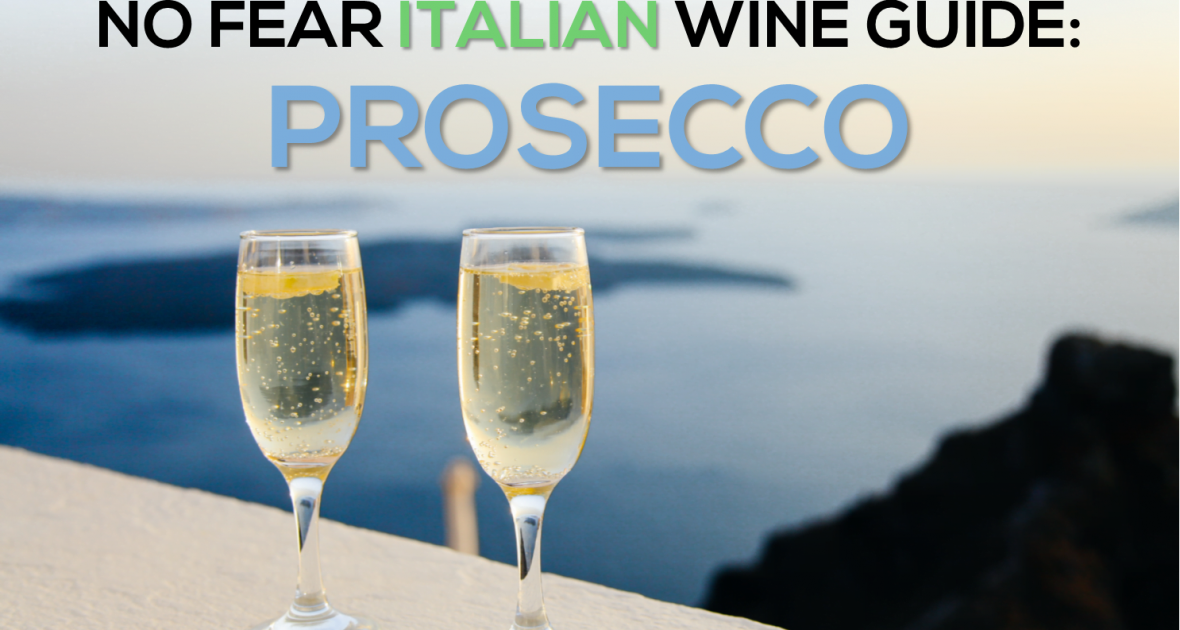WHAT TO EXPECT
Prosecco is, without question, the world’s favorite sparkling wine. Outselling Champagne and Cava combined in recent years, Prosecco has become the standard for “sparkling wine” in restaurants and households worldwide. It’s grown so popular, in fact, that in recent years (particularly 2015) there have been fears of shortages in being able to keep up with the demand. (The horror!) But what exactly is Prosecco, and what makes it different from any other sparkling wine?
First, here’s a little vocabulary lesson that applies not only to Prosecco, but to a lot of other sparkling wines made around the world as well:
- Spumante: Italian for “sparkling wine” with full-on carbonation; all Prosecco is spumante
- Frizzante: meaning “crisp” or “fizzy” in Italian; term for a slightly carbonated wine that is more effervescent rather than sparkling; Moscato d’Asti is an example of frizzante
- Extra Dry: technically an “off-dry” style, most Prosecco is Extra Dry. Between 12-17 grams of sugar per liter; fruity with perhaps a touch of sweetness
- Brut: a sparkling wine with no more than 12 grams of sugar per liter; no discernable sweetness
- Cuve close: bulk-production process for sparkling wine, in which the base wine is combined with sugar and yeast in a big tank to undergo secondary fermentation and then bottled; perfect for retaining the fresh, fruity quality of sparkling wines made in this method
- Method Champenoise: process for sparkling wine that must be used in Franciacorta, Champagne, and a few other high-end sparkling wines
Because Prosecco is made using the cuve close method, it will hardly ever be expensive. Only a few premium labels will command higher prices, with most of these coming from a tongue-twisting village called Valdobbiadene, located in the rolling hills just north of Venice. These wines have a more serious tone to them, with more refined flavors and aromas.
You can expect crisp, ripe flavors of apple, pear, and gentle citrus notes in Prosecco. The bubbles are big and lively, and because most Prosecco is Extra Dry (a confusing term for something very slightly sweet), it’s an easy sparkler to love—and to put in Mimosas.
- Did you know? If the label says “Prosecco,” it’s made with grapes of the same name—Prosecco! But Prosecco grapes also have another name: Glera. It’s extremely rare, but it’s possible to find still Glera without carbonation.
Perfect Pairings: The youthful fruitiness of Prosecco is a perfect foil for the saltiness of prosciutto. (If you need a killer party-starter, pour Prosecco next to some prosciutto-wrapped melon. Molto bene!) Prosecco is also a great match for frutti di mare, spicy Asian entrées, or even simple snacks like potato chips or buttered popcorn.
Fail-Proof Pairing: Our Cheese Shop has a little in-house creation that’s absolutely to die for: Signature Chevre. Creamy goat cheese medallions are topped with a signature blend of dried fruits, nuts, herbs, and olive oil that absolutely melts in your mouth. The sweetness of the fruit and tanginess of the chevre is an absolutely perfect pairing with the Nino Franco Prosecco Valdobbiadene Brut
THE CLASSICS
Mionetto Prosecco Brut, $14.99
Nino Franco Prosecco Valdobbiadene Brut, $21.99
SOMETHING DIFFERENT
Zardetto Spumante Rose, $13.99: This delightful spumante is made not from Prosecco grapes but from Raboso Veronese, which gives the wine its lovely soft-pink color as well as its vibrant acidity. Elegant and expressive, it has fresh aromas of cherry and red currant with a crisp, refreshing finish. Best paired to Parmigiano Reggiano and salame!
Lini Labrusca Rose Lambrusco, $19.99: Coming from the plains of Emilia between Parma and Bologna, Lambrusco is made in the same fashion as Prosecco—except with red grapes! This gorgeous rose Lambrusco is made from two strains of Lambrusco grapes—Salamino and Sorbara—and after a very short time on the skins, the juice is drawn off and then goes through secondary fermentation. It has intense aromas of ripe cherry and rose petals, followed by a crisp, fresh palate with nicely balanced acidity. Pair with antipasti, seafood, cheeses, and light pasta dishes.
Ronco Calino Franciacorta, $33.99: Franciacorta separates itself from any other sparkling Italian with one clear distinction: by law, it must be made in the same fashion as French Champagne—that is, the secondary fermentation (how it gets its bubbles) happens inside each individual bottle instead of in a large tank. This method, called methode champenoise, is costlier and more time-consuming, but ultimately higher quality. This Ronco Calino Franciacorta, made from 100% Chardonnay, is a prime example with its fine strands of bubbles (much smaller than in Prosecco), more delicate and nuanced aromas and flavors, and longer finish. Expect a bouquet of white lilac, acacia and orange blossom on the nose, followed by a palate full of pineapple, pear, and white cherry, as well as hints of honey, lime, and sage.
